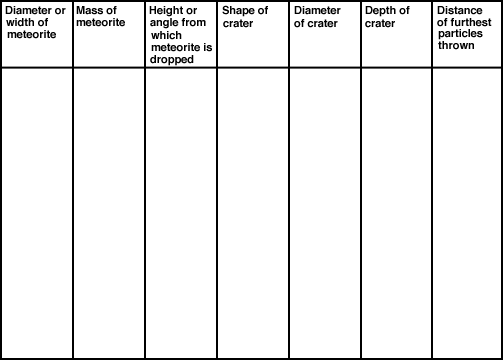The Doomsday Asteroid
|  |
Student Handout |
Crater Analysis
By making observations of craters, scientists can gain information about force, size, and mass of the objects that strike a surface. You can practice these skills by doing this activity.
Procedure
On a separate sheet of paper, create a chart like the one below and record all your data on the chart to make comparisons. Fill the tray with sand. Sprinkle a thin layer of flour over the top of the sand. The flour will make it easier for you to observe the features of your crater. Select a "meteorite" to drop onto your surface. Measure the mass and diameter or width of the object and record your data on the chart. Measure the height from which the meteorite will be dropped. Drop the meteorite onto the surface. Carefully remove it and measure the size and depth of the crater. Measure the distance between the crater and the furthest particles of sand or flour that were thrown out of the crater with the impact of the meteorite. On the graph paper, create a map of the location of each crater. Number the craters according to the sequence in which they were created. Repeat steps 2 - 5 with other objects until you have created several craters. Try dropping or tossing a few meteorites at an angle rather than straight down onto the surface.

Analyzing the Results
Answer the following on a separate sheet
How can you tell which craters were formed first or last? What variables affect the shape and size of the crater? What features are different between craters formed by a meteorite that falls straight down and a meteorite that strikes at an angle? What features are similar among all the craters? Carefully exchange your tray of sand with another group and analyze the craters in the tray you receive. Which craters seem to be oldest? Which seem to be youngest? What evidence can you find about the size and mass of the meteorites? Which craters were formed by meteorites that struck at an angle? After you have investigated the other group's craters, exchange graph paper so that you can check your analysis.
|
